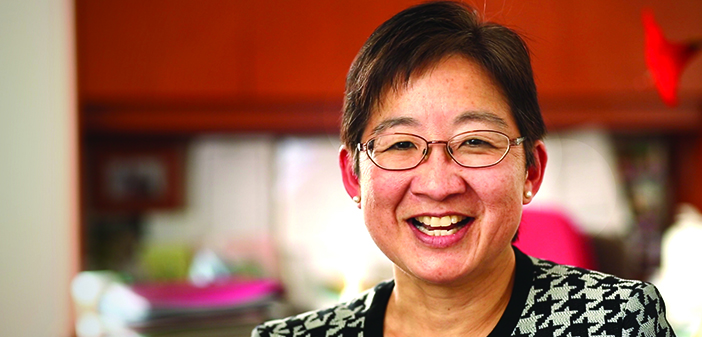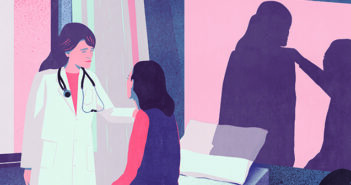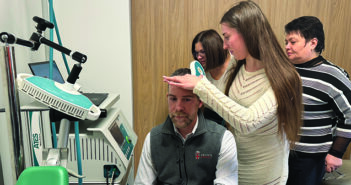A school-based clinic strives for total health.
About a quarter of Baltimore students are chronically absent from school every year, many for acute illness and chronic conditions like asthma. Unsurprisingly, kids who miss a lot of school fall behind academically, are less likely to graduate on time, and are more likely to drop out. It’s a vivid illustration of how health, education, and poverty can intersect to set a child up for a lifetime of lower achievement and lost potential.
Pediatrician Tina L. Cheng, MPH ’83 MD’86 has devoted her career to addressing these disparities. “All the work I’ve done has focused on vulnerable populations and trying to figure out how to interrupt the cycle of disadvantage,” she says. “We need to invest in making sure children are growing up healthy, ready to learn, and on the trajectory to productive adulthood.”
Cheng, who is the director of the Department of Pediatrics for the Johns Hopkins University School of Medicine and pediatrician-in-chief of The Johns Hopkins Hospital, says health and educational disparities are “totally intertwined.” But when students have access to school-based health services, studies have shown that attendance improves. “If we are really going to address health disparities, we can’t do it all in the doctor’s office,” she says. “We really need to go where the kids are.”
In 2014 Cheng partnered with Sara Johnson, PhD, MPH, an associate professor of pediatrics and of public health at Johns Hopkins, to found the Ruth and Norman Rales Center for the Integration of Health and Education. The health center serves more than 1,500 students at two Baltimore charter schools, and logs about 100 school nurse and doctor visits a day. The medical staff, including a physician, treat the usual headaches, sore throats, and playground scrapes. They diagnose and treat all manner of illnesses, and prescribe and fill medications. But that’s just the beginning.
“We wanted a more comprehensive approach, integrated into a school,” Cheng says. The staff screen schoolwide for vision, dental, asthma, and other problems; keep immunizations up to date; and teach kids to manage chronic conditions like asthma and diabetes as well as their medications. The center also has embedded health education into the curriculum, including physical activity and nutrition programs.
Evaluations of the Rales Center’s impact on health and academic outcomes are ongoing, Cheng says, but after two years, already “we have been able to decrease emergency department visits for common conditions like asthma, and decrease absenteeism at school because we take care of health conditions in the clinic.”
Cheng wanted to be a physician ever since her kindergarten days in Iowa, but she shied away from pediatrics in defiance of adults who told her it was “a good field for a woman.” “But then when I did my pediatrics clinical rotation [at Brown], I loved it,” she says. She wanted the opportunity to help kids “make decisions about health behavior that can last a lifetime.” Her interest in preventive medicine and social determinants of health took her to UC Berkeley, where she earned her MPH.
Research and programs on health disparities often focus on adults, Cheng says; she educates and empowers clinicians, researchers, and policymakers to address the inequities that affect children, too. “They’re a little over 10 percent of health care costs in our country, but they’re 100 percent of our future,” she says. “They don’t vote and most kids are fortunately healthy, so I think sometimes they’re not prioritized in health programs that tend to focus on high-cost conditions.”
Cheng has spearheaded numerous initiatives to tackle child health disparities, including the Healthy Generations Program in Washington, DC, which works with teen parents and their children and aims to reduce teen pregnancy and improve child and family outcomes; and the NIH-funded DC-Baltimore Research Center on Child Health Disparities, where she’s the principal investigator of a project to prevent youth violence.
She also sees patients and trains residents at Hopkins’ Harriet Lane Clinic. “I don’t want to ever give that up,” Cheng says of her practice. “That’s the reason why I came into medicine. Whatever I do [at the clinic]informs what I do [elsewhere].”
Cheng, who met her husband, Ken Conca, PhD ’82, when they were undergrads, says their daughter, who’s applying to medical school, and their son, a college sophomore, influence her as well. “Being a parent makes you a better pediatrician,” she says. “It is a great education.”
In her limited spare time, Cheng loves running and volunteers locally. But she can’t imagine spending less time at work. “I always feel I could do more,” she says. Becoming director of pediatrics at Hopkins, last year, gave her “a platform to … make sure every child is healthy.”
“That there’s such a high proportion of kids living in poverty is a real shame,” she says. “We need to try to address that, and also try to buffer the impact that poverty and other adverse experiences have on kids’ developmental trajectory.”




